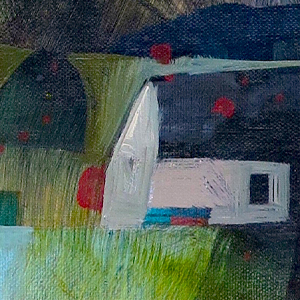
Good Education
The “Great Work” of Teaching
Barbara S. Stengel
Artwork: “In the Waves” by Meryl Blinder © 2024
Educators know what good work is.
At least they should. Educators participate directly in what Matthew Fox (following Ranier Maria Rilke and Meister Eckhardt) calls “the Great Work,” that is, the continuing creation of the cosmos.1 To teach is to see, encourage, and challenge those (young and older) who are our students. To work in schools at any level from pre-school through university is to participate in the creation of communities whose very purpose is the reconstruction of our social life.
I use the term “reconstruction” quite intentionally. Some would say that schools reproduce social life and, to some extent, that is the case. We who serve as educators enter into relation with students with some basic productive and reproductive goals in mind, of course. (We call that curriculum). But we also enter with a secret (perhaps subconscious) hope that our students will outgrow and outshine us, and in the process bring new life to our ways of being individually and together. That new life, that reconstruction, is indispensable to the health and welfare of any community, but it is also, at root, unpredictable. Teachers plan and design for the growth and development of their students, but they don’t control it. Students bring themselves to the relation—and that makes teaching frustrating and delightful, as well as ever-challenging.
Let me highlight the not-wholly-determinable work of teaching by employing Fox’s framework of meaning and meaningfulness informing creation spirituality: via negativa, via positiva, via creativa, and via transformativa.
There is, of course, drudgery and frustration involved in teaching, as in virtually any form of meaningful work; just ask any teacher who is reviewing student papers and projects on a beautiful Sunday afternoon, shadowed by the spectre of student AI use (via negativa). But there is always also joy if we have eyes to see it (via positiva). Informed by careful attention to how students are growing and guided by what the world needs now, educators are called to bring the frustration and the joy together creatively as they design environments and activities to engage their students in ways that elicit effort and interest (via creativa). And that combination of effort and interest results in the transformation of each student in their own way and—frustratingly at times—at their own pace (via transformativa). Transformation is the visible sign of education well-practiced. If we observe no joy and awe, no creativity and passion, no transformation and rebirth (and yes, no pain and uncertainty), there is no education—no matter how much effort is demanded or invested. What does this look like in the quotidian work that teachers do? I offer two examples.
Watching my grandchildren grow under the watchful eye of their teachers
My grandchildren attend an urban Catholic school located just a few blocks from my home in a small city in Pennsylvania, a school I serve by acting as informal advisor for the relatively new principal and by coaching the 3rd and 4th grade boys’ basketball team. It is a K–8 school of just 180 students. Each week, the school circulates a newsletter to parents, volunteers, and donors, and the final segment of the newsletter each week is “Seen around School.” Week after week, there are photos of children between the ages of 5 and 14 growing in love and grace right before the eye of the camera. They are sitting on the hallway floor leaning on—and working with—their friends; they are standing proudly—individually and in groups—before the camera to celebrate this or that moment of growth. They are only vaguely aware of the work and worry of their teachers, teachers who plan each day with each and every child in mind, teachers who communicate faithfully with parents—sharing good news and enlisting parents as allies in addressing problems, teachers who are paid less than they would be in the public school across the street. These teachers are well-aware of the difficulties facing a parochial school where funding is always an issue, and aware also of the personal and societal challenges facing their students.
But the positiva, the creativa, and the transformativa are evident in both everyday and occasional activities of children. Just weeks ago, I experienced the joy (and humor!) of watching Mother’s Day videos one grandson and one granddaughter, both kindergartners, created for their mothers with the help of their quite wonderful teacher. Mrs. L interviewed each kindergartner and edited those interviews into a video that began with a common introduction, featured the kindergartner talking about his or her mother (or primary parent), and then brought the entire class in to sing a song together in honor of the love of a mother. The positive energy and the creativity of the project enabled each mother (and me, by extension) to bear witness to the transformation of the child from a shy five-year-old into an outspoken six-year-old able to express their powers of observation and appreciation of love as a force in their lives. This took work, but the work was supported and worth it.
Sometimes the everyday insecurities of middle schoolers interrupt the loving community of the school. Sometimes adolescents don’t control their impulses as well as we educators might like. How the principal and the teachers respond to frustration—the students’ and their own—is what determines whether this is a moment of growth for students. In one such interruption involving a posse of sixth graders and unnecessary disrespect for their teachers and each other, the principal and middle school teachers focused together on the quality of the class community. Rather than “discipline” just the apparent offenders, they gathered the class, employed an outside facilitator, and created the conditions for the students and teachers to diagnose the problem and solve it together. It is early days for the solution they fashioned, but the results are promising for both individual students and teachers the class as a whole. Struggle, faith, creativity, and new possibility exist together in the work of those teachers.
Sharing responsibility in a public urban middle school
For four years, from 2012 to 2016, I worked closely with the faculty and administration of a public middle school in Nashville, TN that could only be described as “troubled.” The new principal, a friend of mine, arrived with a clear focus on taking care of teachers so that they could take care of youngsters in a way that addressed trauma and insecurities of all kinds as they raised the bar on academic growth.
Together we found ways to expand and enhance relational capacity in the school by minimizing formal administrative roles and redistributing those resources toward empowering teachers and teacher leaders. Grade-level teams of teachers—content teachers, a special educator, a counselor, paraprofessionals, and residents from my teacher education program—led by one of their own took on virtually every function that ensured the well-being of students. This meant that student grouping, targeted social and academic interventions, instructional planning, daily schedules, and assessment were all in the hands of the teacher-led teams. That this required intellectually and emotionally demanding effort goes without saying. But the presence of supportive teams (flexibly operating to give each other a break when the demands threatened to break them) enabled the teachers to see, encourage, and challenge each and every student.
Because of the positive support and the encouraged team-based creativity, the school was gradually but steadily transformed from troubled to energized. The teachers were transformed from competent if overloaded to inspired and inspiring. Stunningly, the students came quickly to understand themselves as, in the words of the morning motto, “individuals of character, scholars for life, leaders now and tomorrow,” a descriptor confirmed by their continuing loyalty to their middle school experience, and the life milestones (college graduation and job advancement) that they regularly post to social media.
There are innumerable stories to be told about my four years in that school that would confirm the heartache, the joy, the innovation, and the resulting growth of all involved. But I’ll mention just two: the move to algebra for the entire 8th grade class and the experience of one particular seventh-grader who, with the help of an advocate teacher, shed his special education label.
Too many of the school’s students (upwards of 85%) were failing to achieve proficiency on required state math tests, a source of great frustration for their teachers. So the math team pivoted away from failure and toward possibility, making a unilateral decision to teach algebra to all eighth graders, even those who were “below basic” in the previous year. That move required some curriculum adjustment and a supportive team effort to keep students’ heads in the game. At the end of the year, the experiment and the faith it demanded paid off. Seventy-five percent of the students passed the algebra test and qualified for high school geometry! The evident joy and pride the day the test scores came back was infectious. Even the students who didn’t master algebra took pride in their capacity to do hard things. And the expectations all students had for themselves in this previously low-achievement school went up a notch or two.
While the eighth graders were growing as a group, one seventh grader was resisting labels imposed on him early in his school career. He believed that he could learn and grow with the support of his teachers but without the limits of a special education tag. This was partly because his team of teachers had so integrated students of varying needs with differentiated instruction that he experienced keeping up and, in some areas, forging ahead. When he asked the special education teacher whether he needed the label, she heard him and began a not-so-simple process of advocacy—and frustrating paperwork—that freed him. He flourished. Her work paid off. A life was changed.
Teachers’ work integrates the via negativa (uncertainty, darkness, discouragement, even suffering), the via positiva (awe, delight, gratitude and joy), the via creativa (creativity and passion), and the via transformativa (justice, healing, celebration). These characteristics of work well done come together in the reproduction of what is worth preserving and in the reconstruction of individual lives and communal interaction. This is success.
But to achieve success understood in this way, that is, to allow teachers to experience their work in the ways I have characterized above, we need, says Fox, “wisdom schools” rather than the current “knowledge factories.”2 Wisdom schools do not reduce education to mere training ground for jobs (rather than work worthy of the title). And when we think of education as merely preparation for job, we lose our energy for education, rightly understood.
American philosopher John Dewey cautions that “the most needed of all reforms in the spirit of education [is that we stop] conceiving of education as mere preparation for later life, and make it the full meaning of the present life.”3 When teachers are unable to integrate the negative, the positive, the creative, and the transformational into their work, the cost to our individual and social lives is beyond measure. I fear we are experiencing that today in a long season of education policy inspired by narrowly construed economic goals.
The two schools I profiled above are wisdom schools; they do not fall into that trap. The teachers are well-aware of the fiscal constraints and socio-political realities that challenge them and their students. Nonetheless, they are willing to work hard, to persist through disappointment, to do what they can to change students’ lives and possibilities. And what they can do is impressive! That they and their students celebrate together the power of human growth completes the circle of teachers’ work.
Matthew Fox reminds us that, for the Celts, only poets could be teachers, because poets knew, in their minds and in their hearts, “that knowledge that has not passed through the heart could be dangerous.”4 Put another way, there is no education without spirit. I could cite famous educators like Maria Montessori or Rudolph Steiner—or Dewey—to back up this point, but I suspect I don’t need to. If you think about the moments in your educational experience—in and out of schools—that changed you, they are marked by Spirit, that is, the integration of discomfort, joy, creativity, and transformation that teachers know—and desire—as the best part of their work. There is complexity, mystery, and yes, a fair dose of chaos involved in an effort that is never fully determined.
It is left to all of us to support wisdom schools and the teachers who do this “Great Work.”
Notes
- Matthew Fox, The Reinvention of Work: A New Vision of Livelihood for our Time (Harper Collins, 1994).
- Fox, Reinvention, p. 170.
- John Dewey, The Collected Works of John Dewey, Jo Ann Boydston, ed. (Southern Illinois University Press, 1969–1991). (“Self-realization as the Moral Ideal,” EW 4: 50).
- Fox, Reinvention, p. 171.
 Barbara S. Stengel is professor emerita of philosophy of education and teacher education at Vanderbilt University. She is the author of several books, most recently, Responsibility: Philosophy of Education in Practice (Bloomsbury, 2023). Stengel is a former President of the Philosophy of Education Society and current President of the John Dewey Society.
Barbara S. Stengel is professor emerita of philosophy of education and teacher education at Vanderbilt University. She is the author of several books, most recently, Responsibility: Philosophy of Education in Practice (Bloomsbury, 2023). Stengel is a former President of the Philosophy of Education Society and current President of the John Dewey Society.
Fall 2025
Part I: Employing Virtue
Chris Higgins
Anna Bonta Moreland
Karen E. Bohlin
Zena Hitz
Interlude: Meaningful Employment
Michelle Weise
Part II: Employing Vocation
MORE

















